Creeping Mahonia Mahonia repens

ABOUT
Mahonia repens, commonly known as creeping mahonia or creeping Oregon grape, is an evergreen shrub that is noted for its attractive and distinctive appearance. The plant features compound leaves which are made up of multiple small, holly-like leaflets. These leaflets are typically shiny green on top and paler beneath, and they often take on a reddish tinge during the fall and winter months, adding a splash of color to the garden. The leaves are known for their spiny edges, which makes them look similar to holly leaves. In late spring to early summer, the plant produces small, bright yellow flowers that are clustered in racemes at the tips of the branches. These flowers are quite fragrant and can attract a variety of pollinators, including bees. Following the flowering period, creeping mahonia bears dark blue-purple berries that are covered with a powdery bloom. These berries are not only ornamental but are also edible, with a tart flavor that is sometimes used to make jellies and other preserves. The overall form of the plant is low and spreading, and it tends to have a dense, bushy appearance. Its textured foliage, showy flowers, and colorful berries make it a popular choice for ground cover, in rock gardens, or as part of a woodland garden setting. The creeping mahonia's leathery leaves and its ability to adapt to a variety of soil conditions contribute to its resilience in different environments, making it a versatile and attractive addition to the landscape.
About this plant
 Names
NamesSynonyms
Creeping Oregon Grape, Creeping Barberry, Prostrate Barberry, Creeping Mahonia, Oregon Grape, Repens.
Common names
Berberis amplectens, Berberis pumila, Berberis repens, Berberis sonnei, Mahonia amplectens, Mahonia pumila, Mahonia sonnei, Odostemon repens, Odostemon sonnei.
 Toxicity
ToxicityTo humans
The plant commonly known as Creeping Mahonia is not typically considered highly toxic to humans. However, if ingested in large amounts, its berries can potentially cause mild gastrointestinal upset, including nausea, vomiting, and diarrhea. It is important to exercise caution and avoid consuming parts of the plant unless you are certain of their safety and have identified them correctly, as they may be easily confused with other, more harmful berries.
To pets
Creeping Mahonia may also pose a risk to pets if ingested. Similar to humans, the consumption of this plant, especially in large quantities, can lead to gastrointestinal upset in pets, such as vomiting and diarrhea. It is advisable to keep pets away from the plant to prevent any potential toxicity. If you suspect your pet has ingested Creeping Mahonia, it is best to consult a veterinarian.
 Characteristics
CharacteristicsLife cycle
Perennials
Foliage type
Evergreen
Color of leaves
Green
Flower color
Yellow
Height
1 feet (0.3 meters)
Spread
2 feet (0.6 meters)
Plant type
Shrub
Hardiness zones
5
Native area
North America
Benefits
 General Benefits
General Benefits- Low-Maintenance: Mahonia repens, commonly known as creeping mahonia, requires minimal care once established, making it a hassle-free addition to gardens.
- Drought-Tolerant: Creeping mahonia can survive with limited water, which is beneficial in xeriscaping and in regions with water restrictions.
- Wildlife Attraction: The plant provides nectar for pollinators and its berries are a food source for birds, enhancing biodiversity.
- Shade Tolerance: Creeping mahonia can thrive in shaded areas where other plants may not grow as well, making it ideal for understory plantings and woodland gardens.
- Erosion Control: The spreading nature and dense growth of creeping mahonia make it effective at stabilizing soil and preventing erosion on slopes.
- Year-Round Interest: With evergreen leaves, yellow flowers, and blue-black berries, creeping mahonia provides visual interest throughout all seasons.
- Ground Cover: Its growth habit makes it suitable as a ground cover, filling in spaces and suppressing weeds naturally.
- Landscape Texture: The spiky, holly-like leaves of creeping mahonia add unique textural contrast to landscape designs.
 Medical Properties
Medical Properties- Antimicrobial: Contains compounds that may help to inhibit the growth of certain bacteria, fungi, and protozoa.
- Anti-inflammatory: Has been used traditionally to help reduce inflammation.
- Antioxidant: Contains antioxidants that may protect the body's cells from damage caused by free radicals.
- Hepatoprotective: May offer some protection to the liver from toxic substances.
- Gastrointestinal relief: Employed historically for treating stomach upsets and dyspepsia.
- Bitter tonic: The bitter compounds may stimulate digestion and liver function.
 Air-purifying Qualities
Air-purifying QualitiesThis plant is not specifically known for air purifying qualities.
 Other Uses
Other Uses- Mahonia repens, commonly known as creeping Oregon grape, can be used as a natural dye due to the vibrant yellow color derived from its roots.
- The plant's berries can be made into jams, jellies, and preserves, offering a unique tart flavor that is rich in vitamin C.
- Creeping Oregon grape berries can be fermented to make wine, providing a distinctive, regional beverage.
- The tough, spiny leaves of the plant can serve as a natural barrier when planted in dense thickets, deterring human and animal intruders.
- Its evergreen foliage provides year-round ground cover, helping with soil stabilization and preventing erosion on slopes.
- Creeping Oregon grape can be utilized in permaculture designs as it is attractive to pollinators and provides food for local wildlife.
- The glossy, holly-like leaves can be incorporated into floral arrangements and wreaths, especially during the winter months due to their year-round presence.
- When planted en masse, Mahonia repens serves as a low-maintenance, drought-tolerant landscaping solution for parks and large gardens.
- The plant can be propagated easily from cuttings or seeds, allowing for cost-effective expansion of green spaces or restoration of native plant areas.
- Through companion planting, creeping Oregon grape can be used to provide protective shade and moisture retention for more delicate neighboring plants.
Interesting Facts
 Feng Shui
Feng ShuiThe Creeping Mahonia is not used in Feng Shui practice.
 Zodiac Sign Compitability
Zodiac Sign CompitabilityThe Creeping Mahonia is not used in astrology practice.
 Plant Symbolism
Plant Symbolism- Resilience: Creeping Oregon grape, or Mahonia repens, can thrive in tough soil conditions and shaded environments, symbolizing an individual's ability to persevere through challenging circumstances.
- Protection: The spiny leaves of the Creeping Oregon grape can represent protection and defense against adversity due to their sharp nature.
- Nature's Bounty: With the plant producing edible berries, it signifies the generous gifts of nature and the abundance it can provide.
- Healing: Historically, the roots and berries of the Creeping Oregon grape have been used in traditional medicine, symbolizing healing and the curative power of nature.
 Water
WaterCreeping Mahonia requires consistent moisture but is relatively drought-tolerant once established. During the first growing season, it's crucial to water it deeply once a week, providing about 1 gallon of water per plant to ensure good root development. Afterward, watering can be reduced to every two to three weeks, depending on the climate and soil conditions. It is important not to overwater to prevent root rot, as the Creeping Mahonia prefers soil that is moist but well-draining. Increase watering during prolonged dry spells, especially if the plant is exposed to full sun.
 Light
LightCreeping Mahonia thrives best in partial shade, though it can tolerate full sun in cooler climates. The ideal location would receive morning sunlight and afternoon shade or dappled sunlight throughout the day. Avoid deep shade as this may lead to reduced vigor and fewer blooms.
 Temperature
TemperatureCreeping Mahonia is hardy and can withstand a temperature range from approximately 0 to 85 degrees Fahrenheit. It can survive brief periods of temperatures slightly below freezing but should be protected from severe cold. The ideal temperature range for optimal growth is between 40 and 70 degrees Fahrenheit.
 Pruning
PruningPrune Creeping Mahonia to maintain its shape and encourage bushier growth. The best time to prune is after it finishes blooming in late spring or early summer. Remove any dead, damaged, or overcrowded branches, cutting back to a healthy set of leaves or buds. Pruning can be done annually or as needed to control its size.
 Cleaning
CleaningAs needed
 Soil
SoilCreeping Mahonia thrives in a well-draining soil mix comprising a combination of garden soil, compost, and perlite or sand to ensure adequate drainage. Ideal soil pH for Creeping Mahonia ranges from slightly acidic to neutral (pH 5.5 to 7.0). Regular mulching can help maintain soil moisture and provide essential nutrients.
 Repotting
RepottingCreeping Mahonia is a slow-growing plant and does not require frequent repotting. It should be repotted every 2 to 3 years, or when it outgrows its current pot, to provide fresh soil and additional space for root growth.
 Humidity & Misting
Humidity & MistingCreeping Mahonia prefers moderate to high humidity levels. Ensuring a humidity level of around 30-50% will mimic its natural understory habitat and support its growth.
 Suitable locations
Suitable locationsIndoor
Place Creeping Mahonia in indirect light and maintain moist soil.
Outdoor
Plant in partial shade, ensure drainage, water regularly.
Hardiness zone
5-9 USDA
 Life cycle
Life cycleOregon Grape (Mahonia repens) begins its life cycle when seeds, often dispersed by birds who eat the berries, germinate in moist, well-drained soils, ideally in partial to full shade. Seedling emergence is followed by the growth of a rosette of pinnate, spiny leaves, distinctive to the plant. As it matures, Oregon Grape develops into a low-growing, evergreen shrub with leathery leaves that can turn reddish-purple in winter. Yellow flowers bloom in early spring, attracting pollinators, which then give way to bluish-black, grape-like berries by late summer. These berries contain seeds that, once again, perpetuate the life cycle when dispersed. As a perennial, this plant can survive for many years, spreading slowly by producing new shoots from its rhizomatous root system.
 Propogation
PropogationPropogation time
Spring to summer
Propogation: Creeping Mahonia, or Mahonia repens, is often propagated through semi-hardwood cuttings. This method is most successful when performed in late summer. For the procedure, cut a 4-6 inch (10-15 centimeter) length of stem that includes several sets of leaves. After cutting, the lower leaves should be removed and the cut end dipped in rooting hormone to encourage root growth. The cutting should then be placed in a pot filled with a mix of peat and perlite or sand to provide good drainage and aeration. The soil must be kept moist but not wet, and the cuttings should be placed in indirect light. Roots usually develop within a few weeks, after which the new plants can be transplanted into individual pots or into the garden.
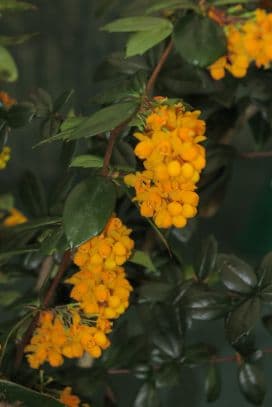
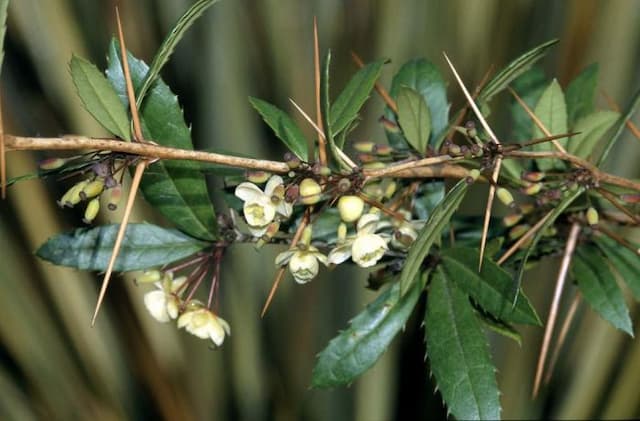
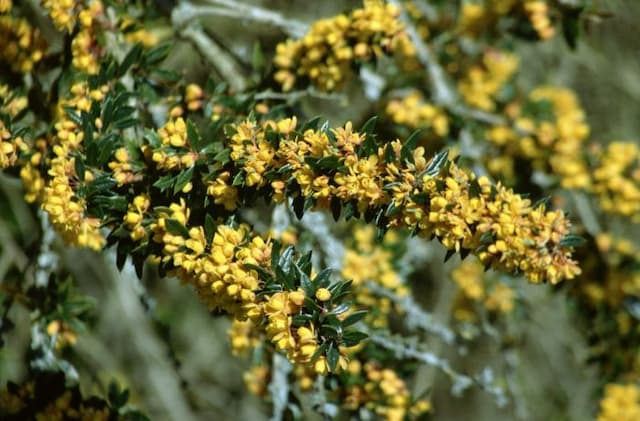
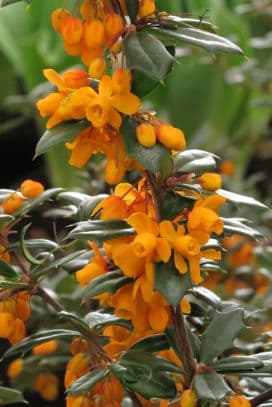
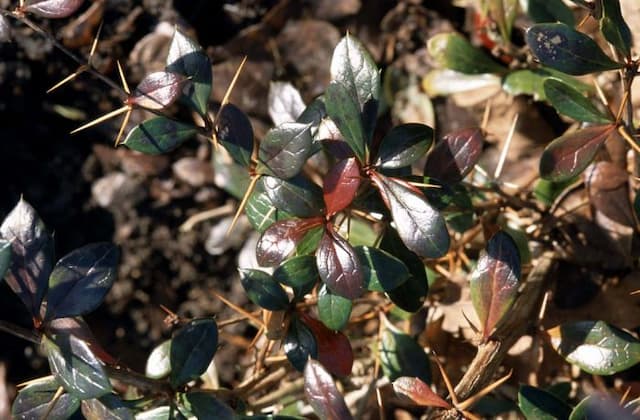



![Japanese barberry [Bonanza Gold]](/_next/image?url=https%3A%2F%2Fplants-admin.emdemapps.com%2Fimages%2Fplants%2F%2Fimages%2F604b5385e413f.png&w=640&q=75)
